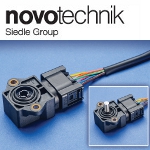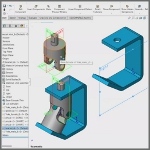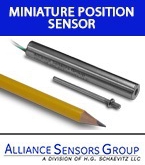 |
| May 16, 2023 | Volume 19 Issue 19 |
Electrical/Electronic News & Products
Designfax weekly eMagazine
Archives
Partners
Manufacturing Center
Product Spotlight
Modern Applications News
Metalworking Ideas For
Today's Job Shops
Tooling and Production
Strategies for large
metalworking plants
Durable, full redundant angle sensors for automotive and off-highway
 Novotechnik's new RSK-3200 Series angle sensors are designed for harsh automotive and off-highway applications. Measurement range is 0 to 360 degrees, and the temperature range is -40 to 125 C. This unit's built-in coupling accepts D-Shaft, with shaft customization available. The sensors are sealed to IP 67 or IP 69k depending on version. RSK-3200 Series sensors are extremely durable with MTTF of 285 years for each of the two channels! Applications include throttle control and EGR valves, transmission gear position, and accelerator position. Very competitive pricing.
Novotechnik's new RSK-3200 Series angle sensors are designed for harsh automotive and off-highway applications. Measurement range is 0 to 360 degrees, and the temperature range is -40 to 125 C. This unit's built-in coupling accepts D-Shaft, with shaft customization available. The sensors are sealed to IP 67 or IP 69k depending on version. RSK-3200 Series sensors are extremely durable with MTTF of 285 years for each of the two channels! Applications include throttle control and EGR valves, transmission gear position, and accelerator position. Very competitive pricing.
Learn more.
Great design: Handle with integrated lighting/signaling
 Signaling and indicator lights, switches, and buttons -- elements that hardly any machine can do without. The new JW Winco cabinet U-handle EN 6284 integrates all these functions into a single, compact element. The new U-handle is designed to enhance the operation of systems and machines. It features an integrated button and a large, colored, backlit area on the handle. These elements can be used individually or in combination, providing a versatile tool for system control and process monitoring that can be seen from across the room.
Signaling and indicator lights, switches, and buttons -- elements that hardly any machine can do without. The new JW Winco cabinet U-handle EN 6284 integrates all these functions into a single, compact element. The new U-handle is designed to enhance the operation of systems and machines. It features an integrated button and a large, colored, backlit area on the handle. These elements can be used individually or in combination, providing a versatile tool for system control and process monitoring that can be seen from across the room.
Learn more.
World's most popular 3D multisensor metrology systems get next-gen addition
 Offered in two benchtop and two floor-model options to handle nearly any size part, the SmartScope M-Series systems from Optical Gaging Products usher in the next generation of enhancements in image accuracy, optics, and throughput to the world's most popular 3D multisensor video measurement platform. SmartScope M-Series features fixed optics with a 20-megapixel camera and proprietary Virtual Zoom, combined with advanced sensors, illumination, and accessories, to achieve class-leading optical measurement speeds. Lots more features.
Offered in two benchtop and two floor-model options to handle nearly any size part, the SmartScope M-Series systems from Optical Gaging Products usher in the next generation of enhancements in image accuracy, optics, and throughput to the world's most popular 3D multisensor video measurement platform. SmartScope M-Series features fixed optics with a 20-megapixel camera and proprietary Virtual Zoom, combined with advanced sensors, illumination, and accessories, to achieve class-leading optical measurement speeds. Lots more features.
Learn more.
SOLIDWORKS Tips: 3 easy ways to focus on your model
 SOLIDWORKS Elite Applications Engineer Alin Vargatu demonstrates his top tips for focusing on your model: finding planes the easy way inside your assembly with the Q key, breadcrumbs, and a better way to use the component preview window. Very helpful. Lots more tips on the SOLIDWORKS YouTube channel.
SOLIDWORKS Elite Applications Engineer Alin Vargatu demonstrates his top tips for focusing on your model: finding planes the easy way inside your assembly with the Q key, breadcrumbs, and a better way to use the component preview window. Very helpful. Lots more tips on the SOLIDWORKS YouTube channel.
View the video.
Push-pull transformer drivers for automotive power supplies
 Nexperia's AEC-Q100 qualified, push-pull transformer drivers (NXF6501-Q100, NXF6505A-Q100, and NXF6505B-Q100) enable the design of small, low-noise, and low-EMI isolated power supplies for a range of automotive applications such as traction inverters and motor control, DC-DC converters, battery management systems, and on-board chargers in EVs. Also suitable for industrial applications such as telecommunications, medical, instrumentation, and automation equipment.
Nexperia's AEC-Q100 qualified, push-pull transformer drivers (NXF6501-Q100, NXF6505A-Q100, and NXF6505B-Q100) enable the design of small, low-noise, and low-EMI isolated power supplies for a range of automotive applications such as traction inverters and motor control, DC-DC converters, battery management systems, and on-board chargers in EVs. Also suitable for industrial applications such as telecommunications, medical, instrumentation, and automation equipment.
Learn more.
Mini linear position sensor for drones, robots, aero, more
 H. G. Schaevitz LLC, Alliance Sensors Group is now offering a miniature, lightweight LZ SERIES linear position sensor product line utilizing LVIT Technology™. These sensors are designed for tight spaces that require excellent stroke-to-length ratio. They are contactless devices for use by drones, OEMs, aerospace, robotics, factory automation, or assembly machinery applications where precision in position sensing is crucial.
H. G. Schaevitz LLC, Alliance Sensors Group is now offering a miniature, lightweight LZ SERIES linear position sensor product line utilizing LVIT Technology™. These sensors are designed for tight spaces that require excellent stroke-to-length ratio. They are contactless devices for use by drones, OEMs, aerospace, robotics, factory automation, or assembly machinery applications where precision in position sensing is crucial.
Learn all the specs.
What is a Heatric Printed Circuit Heat Exchanger?
 According to Parker Hannifin, "A Printed Circuit Heat Exchanger is a robust, corrosion-resistant, high-integrity plate-type heat exchanger manufactured using diffusion bonding." Learn about the technology and why Heatric, a Parker brand, "can manufacture a unit up to 85% smaller and lighter than traditional technologies such as shell and tube heat exchangers."
According to Parker Hannifin, "A Printed Circuit Heat Exchanger is a robust, corrosion-resistant, high-integrity plate-type heat exchanger manufactured using diffusion bonding." Learn about the technology and why Heatric, a Parker brand, "can manufacture a unit up to 85% smaller and lighter than traditional technologies such as shell and tube heat exchangers."
Read this informative Parker blog.
Tech Tip: Mastering sheet metal bend calculations in Onshape
 Mastering bend calculations in sheet metal design is a key skill that can impact the accuracy and manufactur-ability of your designs significantly. Explore the various options available to become a pro in this Onshape Tech Tip: K Factor, bend allowance, and bend deduction, with guidance on when each should be used. You may learn something even if you don't use this software.
Mastering bend calculations in sheet metal design is a key skill that can impact the accuracy and manufactur-ability of your designs significantly. Explore the various options available to become a pro in this Onshape Tech Tip: K Factor, bend allowance, and bend deduction, with guidance on when each should be used. You may learn something even if you don't use this software.
Read the Onshape blog.
Seifert thermoelectric enclosure coolers from AutomationDirect beat the heat
 Automation-Direct has added new high-quality and efficient stainless steel Seifert 340 BTU/H thermoelectric coolers with 120-V and 230-V power options. Thermoelectric coolers from Seifert use the Peltier Effect to create a temperature difference between the internal and ambient heat sinks, making internal air cooler while dissipating heat into the external environment. Fans assist the convective heat transfer from the heat sinks, which are optimized for maximum flow.
Automation-Direct has added new high-quality and efficient stainless steel Seifert 340 BTU/H thermoelectric coolers with 120-V and 230-V power options. Thermoelectric coolers from Seifert use the Peltier Effect to create a temperature difference between the internal and ambient heat sinks, making internal air cooler while dissipating heat into the external environment. Fans assist the convective heat transfer from the heat sinks, which are optimized for maximum flow.
Learn more.
Raspberry Pi Pico 2: Microcontroller board with 2x flash memory
 Raspberry Pi's Pico low-cost, high-performance microcontroller board with flexible digital interfaces is now being offered as a full second-generation product, complete with twice the on-board flash memory, higher performance, lower power consumption, and greater security.
Raspberry Pi's Pico low-cost, high-performance microcontroller board with flexible digital interfaces is now being offered as a full second-generation product, complete with twice the on-board flash memory, higher performance, lower power consumption, and greater security.
Read the full article.
Free-Core vs. Spring-Loaded LVDT position sensors
 Linear Variable Differential Transformers are electro-mechanical devices used in many industrial applications to measure the displacement or position of an object. They convert the linear position or motion of a measured object into an electrical output that is displayed on a local readout or input into a programmable logic controller as part of an automated process control system. LVDTs come in two core configurations -- free-core and spring-loaded -- but do you know what the differences are?
Linear Variable Differential Transformers are electro-mechanical devices used in many industrial applications to measure the displacement or position of an object. They convert the linear position or motion of a measured object into an electrical output that is displayed on a local readout or input into a programmable logic controller as part of an automated process control system. LVDTs come in two core configurations -- free-core and spring-loaded -- but do you know what the differences are?
Read the full NewTek Sensor Solutions article.
New sensor listens to fuel for optimum marine diesel engine performance
 Condition monitoring expert CM Technologies has added a fuel injection acoustic emission sensor to its proprietary PREMET X range of two- and four-stroke diesel engine performance indicators for marine use. The device allows engineers to monitor the acoustic signature of a diesel engine's fuel injection system to detect any problems with fuel injectors, nozzles, and pumps.
Condition monitoring expert CM Technologies has added a fuel injection acoustic emission sensor to its proprietary PREMET X range of two- and four-stroke diesel engine performance indicators for marine use. The device allows engineers to monitor the acoustic signature of a diesel engine's fuel injection system to detect any problems with fuel injectors, nozzles, and pumps.
Read the full article.
Application Note: Quadcopter propeller torque/thrust testing
 The quadcopter's four propellers are designed to work in conjunction with each other to ensure there are no torque imbalances that could send the vehicle spinning out of control. But just how would a professional developer or hobbyist perform accurate propeller torque and thrust testing? Advanced sensor expert FUTEK has the answer.
The quadcopter's four propellers are designed to work in conjunction with each other to ensure there are no torque imbalances that could send the vehicle spinning out of control. But just how would a professional developer or hobbyist perform accurate propeller torque and thrust testing? Advanced sensor expert FUTEK has the answer.
Read the full article.
New enclosure heat exchanger options
 Automation-Direct has added new Saginaw Enviro-Therm® air-to-air heat exchangers that use an enclosure's ambient air and either heat pipes or aluminum plate to transfer heat from inside the enclosure to the external environment. Since the ambient air is the cooling medium, the need for refrigerant is eliminated. Features include corrosion-resistant internal components, a filterless design for maximum cooling and reduced clogging, simple installation, and a programmable digital controller.
Automation-Direct has added new Saginaw Enviro-Therm® air-to-air heat exchangers that use an enclosure's ambient air and either heat pipes or aluminum plate to transfer heat from inside the enclosure to the external environment. Since the ambient air is the cooling medium, the need for refrigerant is eliminated. Features include corrosion-resistant internal components, a filterless design for maximum cooling and reduced clogging, simple installation, and a programmable digital controller.
Learn more.
World's smallest-width floating connector simplifies automotive installation
 Hirose has developed a space-saving, board-to-board connector that combines floating functionality and miniature size to meet automotive specifications. The BM54 Series boasts the world's smallest-width class for its category, a 0.4-mm pitch, and a stacking height of 3.0 to 4.5 mm. This connector is ideal for PCBs with multiple connector sets and offers a wide floating range of +/- 0.4 mm in the XY direction. By absorbing board misalignment errors, floating simplifies assembly and improves assembly work efficiency. Applications include cameras, displays, millimeter wave radar, and LiDAR systems.
Hirose has developed a space-saving, board-to-board connector that combines floating functionality and miniature size to meet automotive specifications. The BM54 Series boasts the world's smallest-width class for its category, a 0.4-mm pitch, and a stacking height of 3.0 to 4.5 mm. This connector is ideal for PCBs with multiple connector sets and offers a wide floating range of +/- 0.4 mm in the XY direction. By absorbing board misalignment errors, floating simplifies assembly and improves assembly work efficiency. Applications include cameras, displays, millimeter wave radar, and LiDAR systems.
Learn more.
New algorithm can make satellite signals act like GPS -- with super accuracy
Researchers have developed an algorithm that can "eavesdrop" on any signal from a satellite and use it to locate any point on Earth, much like GPS. The study represents the first time an algorithm was able to exploit signals broadcast by multi-constellation low Earth orbit satellite (LEO) satellites, namely Starlink, OneWeb, Orbcomm, and Iridium.
The researchers found that by listening to the signals of eight LEO satellites for about 10 minutes, their algorithm could achieve unprecedented accuracy in locating a stationary receiver on the ground and was able to converge on it with an error of only about 5.8 m.
The research, led by Zak Kassas, a professor of electrical and computer engineering at The Ohio State University and director of the Department of Transportation Center for Automated Vehicles Research with Multimodal AssurEd Navigation (CARMEN), was presented in April at the IEEE/ION Position Location and Navigation Symposium (PLANS) 2023 conference in Monterey, CA. Along with Ohio State PhD students Sharbel Kozhaya and Haitham Kanj, the paper, which demonstrated the first-ever exploitation of unknown OneWeb LEO satellite signals, won the conference's Best Student Paper award.
The researchers did not need assistance from the satellite operators to use the signals, and they emphasized that they had no access to the actual data being sent through the satellites -- only to publicly available information related to the satellites' downlink transmission frequency and a rough estimate of the satellites' location.
From transportation to communication systems to the power grid and emergency services, nearly every aspect of modern society relies on positioning, navigation, and timing data from global navigation satellite systems (GNSS), or GPS, that orbit the Earth. Despite this, because GPS system signals are weak and susceptible to interference, they can often become unreliable in certain places such as indoor environments or in deep urban canyons. In addition, GNSS signals are spoofable, which poses serious security risks in safety-critical applications, such as aviation.
In the long term, such complications could lead to a number of navigational and cybersecurity issues, especially as virtually all of our current systems rely heavily on GPS, Kassas said. Technologies on the rise, such as autonomous vehicles, he noted, are beginning to amplify the limitations of our current GNSS systems.
"It's becoming more pressing to find civilian and military alternatives to GPS, whether as a backup or in the case when GPS isn't there whatsoever," said Kassas.
This study builds on previous research by Kassas' lab that solely used six SpaceX satellite signals to pinpoint a location within 10 m of accuracy, which was recently reduced to 6.5 m.
"The Starlink study scratched the surface of what is possible," said Kassas.
His work suggests utilizing signals from LEO satellites as an alternative for humans' positioning, navigation, and timing needs, as they reside about 20 times closer to Earth compared to GNSS satellites, which reside in medium Earth orbit -- a little more than 20,000 km above the planet. According to Kassas, the technology could potentially usher in a new era of positioning, navigation, and timing.
"We are witnessing a space renaissance. Tens of thousands of LEO satellites will be launched into space over the next decade, leading to what is referred to as mega-constellations," he said. "Signals transmitted by these satellites will revolutionize numerous technologies and benefit scientific inquiry in fields such as remote sensing."
What also makes the study so different from all other attempts at creating an alternative to GPS is, unlike previous studies, this algorithm doesn't reverse engineer the signal, said Kassas.
"Our algorithm is agnostic to the LEO constellation," said Kassas. "Our receiver can listen to virtually any satellite signal, trains on the data it's receiving on-the-fly, then deciphers certain features of the signal in a way where we can reconstruct what they are transmitting into location data." To demonstrate the team's new approach, the team applied the algorithm to four different LEO satellite constellations: Starlink, OneWeb, Orbcomm, and Iridium. The algorithm cracked all these signals, with virtually no prior knowledge about what is being transmitted.
Additionally, their algorithm is so sophisticated that the researchers were also able to estimate where the satellites are in space. In order to use the satellite to position ourselves, we need to know where the satellite is located. "That's a very challenging problem, because LEO satellites don't normally broadcast their location, and our publicly available estimates of where they are is off by a few kilometers," said Kassas.
During a stationary experiment to test how the signals worked as an accurate positioning system, researchers set a ground receiver's initial position estimate to the roof of an engineering parking structure at the University of California, Irvine, a spot more than 2,000 miles away from its actual position: the roof of Ohio State's Electroscience Laboratory (ESL) in Columbus, OH. Using the satellite constellations to guess where exactly in the country the receiver actually was, the algorithm was only off by about 5 m.
In another experiment, the researchers tested how the algorithm would fare on a moving vehicle, and mounted the receiver onto the top of a car. First, they used today's navigation technology, which relies on a GPS receiver coupled with an inertial navigation system (INS). They navigated for about 100 m before cutting GPS off, after which they drove for nearly a kilometer. They found that by relying on today's GPS-INS system, they were said to be located about 500 m away from their true location, but with their algorithm, they were found about 4.4 m away. "Our result showed that our system is getting close to what you can do with GPS today," said Kassas.
Although a patent has been filed on the algorithm, the team does plan to continue evolving all of the algorithm's technical abilities, said Kassas.
"GPS is a very mature system that we trust with our lives," he said. "To be able to trust new types of signals with our lives, there will have to be more studies on their accuracy, integrity, and continuity."
Source: The Ohio State University
Published May 2023
Rate this article
View our terms of use and privacy policy
